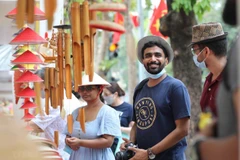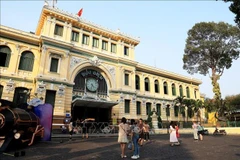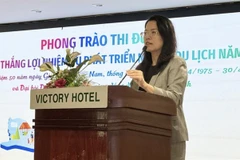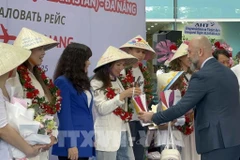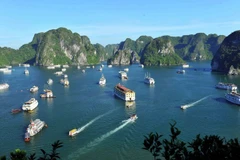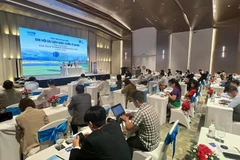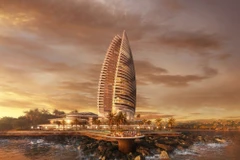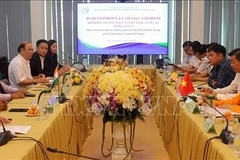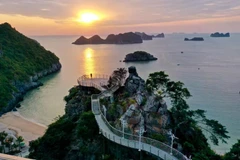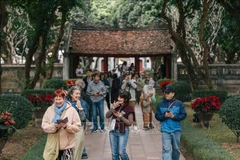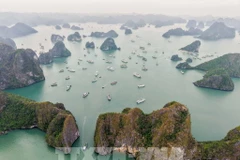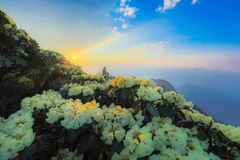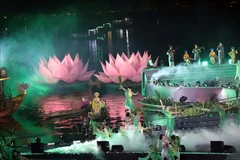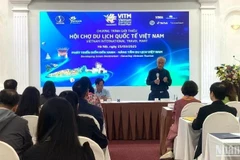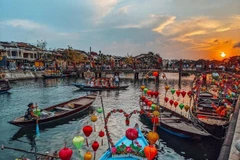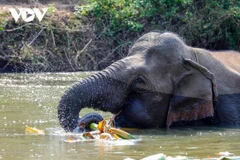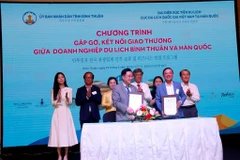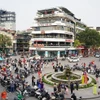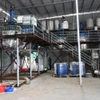 Watering wheels are made from naturally available materials such as thatch, bamboo, rattan, with the great hand skills of Thai people in Na Khuong (Photo: VNA).
Watering wheels are made from naturally available materials such as thatch, bamboo, rattan, with the great hand skills of Thai people in Na Khuong (Photo: VNA).
Hanoi (VNA) - Giant watering wheels in Na Khuong village, Tam Duong district in Lai Chau province, some 30 kilometres southeast of Lai Chau city, operate around the clock delivering fresh water to lush paddy fields by the Nam Mu River. Built by skillful hands of local Thai ethnic minority people, they are not only irrigation facilities but also a symbol, a unique cultural identity of the Thai ethnic minority people in Lai Chau province, and a witness to the great water rice civilisation.
Visiting Tam Duong district in Lai Chau province, tourists are first attracted to nature there, with imposing and endless mountains. But they also find themselves in a pure atmosphere, with the green Nam Mu stream snaking its way among fertile fields, dotted with watering wheels that have become a unique image of Thai ethnic people in Na Khuong hamlet, Ban Bo commune.
About 30km from Lai Chau city, water from the stream spins the huge watering wheels of Na Khuong day in day out next to fertile rice fields of the valley.
Crossing a suspension bridge spanning the stream and wandering along zigzagging lanes, visitors will find beautiful rice fields, surrounded by mountains and hills, in front of them. In the dry season, locals erect from 25-30 wheels to take water from the stream to fields through bamboo pipes.
The wheels are in use until the arrival of the floods, as the violent water will wash them away. They will be re-erected by locals in the ninth month of the lunar calendar.
For as long as anyone can remember, the huge watering wheels slowly turn as the stream flows and are closely associated with the characteristic cultivation practice of the locals. Now, they are must-see structures to visitors when they come to Tam Duong district.
The pristine beauty of the watering wheels in the forests and mountains of the northwestern region is a product of the skilled hands of Thai ethnic people. It takes a lot of assembly and secrets passed from generation to generation to put up the structures and take them down each year. All of the materials needed to make them come from nature. Bamboo, wood, rattan, and strapping are all found in the surrounding natural environment.
The wheels take their shape from paddles and shafts. Depending on the sizes of the wheels, they will have different length and quantity of the spokes which are fixed to the hubs with rattan strings.
On the rims, paddles made from bamboo will be fixed to take the push of the water flow and turn the wheels. Taken to a certain height, the buckets attached on the rims taking water from the stream will pour it into bamboo pipes leading to the nearby terraced rice fields.
Unlike water pumps, the wheels emit no noise and consume no fuel or electricity, and do not impact their surroundings in any way. Their only impact is the beauty in their natural structures dotting the green horizons of the fields against the blue background of the skies. They work night and day, slowly but constantly like eternal automation machines.
After a day of hard work, Na Khuong villagers often take a rest and a bath near the wheels. The image of farmers that care so much for their land in the clear and blue water next to the huge wheels creates a pristine beauty among the forests and mountains, helping attract visitors to the district.
 Huge watering wheels rotating day and night, watering rice fields create an image associated to the daily life of locals for generations. (Photo: VNA).
Huge watering wheels rotating day and night, watering rice fields create an image associated to the daily life of locals for generations. (Photo: VNA).
At the arrival of the dry season, when the watering wheels start to rotate, it is time for thousands of visitors from all the corners of the country to flock here to take in the beauty of the surrounding nature. This is a place where they can relax and enjoy local food, traditional costumes, and plunge themselves into the natural forests and mountains. To have a true experience of local life in Ban Bo, visitors can join in on fishing trips and grill their catches next to Nam Mu stream.
Not only irrigation facilities, watering wheels are also a symbol, a unique cultural identity, and a witness of the water rice civilisation, helping diversify the culture in Vietnam. The erection of the water wheel each year is taken as part of the work for a healthy life, and close to the nature of the Thai ethnic people there./.

